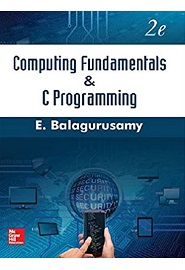
English | 2018 | ISBN: 978-9352604166 | 628 Pages | PDF | 18 MB
We live in a technology-driven world, where almost everything is automated. The last two decades have witnessed a lot of innovations. It can be perplexing for a beginner to keep pace with such developments.
To be lost in the world of codes and bytes can be nerve-racking. And this is where a textbook of this nature comes into picture. Written assuming absolutely no prior knowledge of computers, this book carries the reader through the world of computers in a simple and structured manner.
Computer cannot understand human language thus, a communication medium in form of the computer programming language is required to interact with computer. C is a powerful, fl exible, portable and elegantly-structured programming language.
Since C combines the features of high-level language with the elements of the assembler, it is suitable for both systems and applications programming.
It is undoubtedly the most widely used general-purpose language today in operating systems and embedded system development. Its infl uence is evident in almost all modern programming languages. Since its standardization in 1989, C has undergone a series of changes and improvements in order to enhance the usefulness of the language. The version that incorporates the new features is now referred to as C11.
This book ensures a smooth and successful transition to being a skilled C-programmer.
Fundamentals of Computers and C-Programming starts with basics of a computer system in Chapter 1 and
Computing Concepts in Chapter 2. Gradually it proceeds towards C concepts with Chapter 3 – Overview
of C, Basic Structure of C Programs and Execution. Chapter 4 discusses how to declare the Constants,
Variables, and Data Types. Operators and Expressions are presented in Chapter 5. Chapter 6 deals with
Managing of Input and Output Operations. Chapter 7 talks about Branching. The concept of Decision
Making and Looping is explained in Chapter 8. Arrays, Character Arrays, and Strings have been discussed in
Chapters 9 and 10. User-Defi ned Functions, Structures and Union are covered in Chapters 11 and 12.
While Chapter 13 covers Pointers, Chapter 14 describes File Management in C. Preprocessor is explained
in Chapter 15.
Resolve the captcha to access the links!